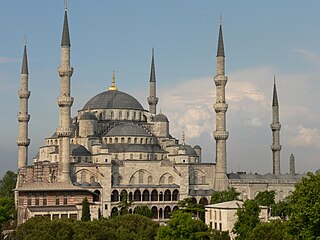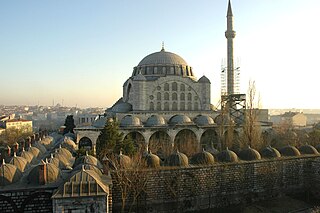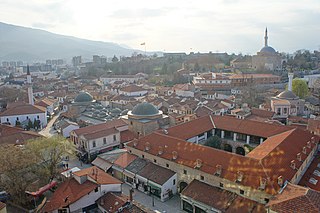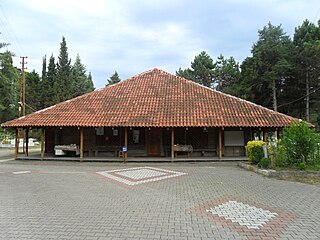
The Selimiye Mosque is an Ottoman imperial mosque, located in the city of Edirne, Turkey. It was commissioned by Sultan Selim II and was built by the imperial architect Mimar Sinan between 1568 and 1575. It was considered by Sinan to be his masterpiece and is one of the highest achievements of Islamic architecture as a whole and Ottoman architecture in particular.

The Bayezid II Mosque is an early 16th-century Ottoman imperial mosque located in Beyazıt Square in Istanbul, Turkey, near the ruins of the Forum of Theodosius of ancient Constantinople.

Ottoman architecture is an architectural style or tradition that developed under the Ottoman Empire over a long period, undergoing some significant changes during its history. It first emerged in northwestern Anatolia in the late 13th century and developed from earlier Seljuk Turkish architecture, with influences from Byzantine and Iranian architecture along with other architectural traditions in the Middle East. Early Ottoman architecture experimented with multiple building types over the course of the 13th to 15th centuries, progressively evolving into the classical Ottoman style of the 16th and 17th centuries. This style was a mixture of native Turkish tradition and influences from the Hagia Sophia, resulting in monumental mosque buildings focused around a high central dome with a varying number of semi-domes. The most important architect of the classical period is Mimar Sinan, whose major works include the Şehzade Mosque, Süleymaniye Mosque, and Selimiye Mosque. The second half of the 16th century also saw the apogee of certain decorative arts, most notably in the use of Iznik tiles.

The large Fatih Mosque is an Ottoman mosque off Fevzi Paşa Caddesi in the Fatih district of Istanbul, Turkey. The original mosque was constructed between 1463 and 1470 on the site of the Church of the Holy Apostles. Seriously damaged in the 1766 earthquake, it was rebuilt in 1771 to a different design. It is named after the Ottoman sultan Mehmed the Conqueror, known in Turkish as Fatih Sultan Mehmed, who conquered Constantinople in 1453.

The Mihrimah Sultan Mosque is a 16th-century Ottoman mosque located near the Byzantine land walls in the Edirnekapı neighborhood of Istanbul, Turkey. It was commissioned by Mihrimah Sultan, the daughter of Suleiman the Magnificent, and designed by the chief imperial architect Mimar Sinan. Sited on the summit of the Sixth Hill near the highest point of the city, the mosque is a prominent city landmark.

The Old Bazaar also known as Turkish Bazaar is a bazaar located in Skopje, North Macedonia, situated on the eastern bank of the Vardar River, stretching from the Stone Bridge to the Bit-Pazar and from the Skopje Fortress to the Serava river. The Old Bazaar falls primarily within the borders of Čair Municipality but a part of it is located in Centar Municipality. As one of the oldest and largest marketplaces in the Balkans, it has been Skopje's centre for trade and commerce since at least the 12th century.

Seljuk architecture comprises the building traditions that developed under the Seljuk dynasty, when it ruled most of the Middle East and Anatolia during the 11th to 13th centuries. The Great Seljuk Empire contributed significantly to the architecture of Iran and surrounding regions, introducing innovations such as the symmetrical four-iwan layout and the first widespread creation of state-sponsored madrasas. Their buildings were generally constructed in brick, with decoration created using brickwork, tiles, and carved stucco.

Samsun Castle was a castle in Samsun, Turkey. Built on the seaside in 1092, it was demolished between 1909 and 1918.

Historical monuments in Pristina are made up of 21 monuments out of a total of 426 protected monuments all over Kosovo. A large number of these monuments date back to the Byzantine and Ottoman periods. Since 1945, the Yugoslav authorities followed the idea of constructing a modern Pristina by relying in the urban development motto “destroy the old, build the new” and this resulted with major changes in the structure of the buildings, their function and their surrounding environment. However, numerous types of monuments have been preserved, including four mosques, a restored orthodox church, an Ottoman bath, a public fountain, a clock tower, several traditional houses as well as European-influenced architecture buildings such as the Museum of Kosovo. These symbolize the historical and cultural character of Pristina as it was developed throughout centuries in the spirit of conquering empires.

The Roman Forum is located in Beirut, Lebanon.

Alaaddin Mosque is a historical mosque in Sinop City, Sinop Province, Turkey.
Beçin was a historical fort in Turkey.

The Yeni Mosque is an Ottoman mosque in the Greek town of Komotini dating back to 1585. It is the only surviving structure in Greece to feature Iznik tiles from the 1580s, the zenith of the Iznik potters' art. The mosque is located in the center of Komotini, adjacent to the Muftiate of Rhodope Prefecture. Next to the Mosque is the Clock tower of Komotini and the Ottoman Turkish baths are found in neighboring areas. Ironically, the New Mosque was built before the Old Mosque of 1608.

Göğceli Mosque is a historic log mosque situated inside the Göğceli Cemetery in Çarşamba, Samsun, northern Turkey. Built during the Seljuk Empire period in the 13th century, the log mosque was constructed without the use of nails.

Samsun Clock Tower is the tower that gives its name to Samsun Saathane Square located in Ilkadim district of Samsun.

The Central Great Mosque is a historic stone mosque situated in İlkadım, Samsun, Turkey. The mosque was first built during the Seljuk Empire period in the 1300s. The original structure caught fire in 1869 and was rebuilt in 1884. Today it is one of Samsun's most beautiful and historical mosques. The Central Great Mosque is located adjacent to the Samsun Clock Tower and Samsun Saathane Square.

Republic Square is a large public square located in Ilkadim district of Samsun, Turkey. It is one of the two largest and busiest public squares in the center of Samsun including Samsun Saathane Square. The square was established in 1931 and has subsequently been renovated and expanded several times. The square sits atop a large municipal parking garage.

Site Mosque is a mosque located in Ilkadim district of Samsun. The mosque is a prominent architectural landmark in the city center due to both its location and unique architectural style. It was built between 1976 and 1985 as part of a redevelopment of the city center. Plans were announced in 2022 to demolish the mosque as part of an urban renewal campaign of Samsun's City Center.

The Basilica of Saint Mark, also known as Hagios Markos, is a former Roman Catholic church in the center of the city of Heraklion, Crete, in the Eleftheriou Venizelou Square. It was built during the Venetian rule of the island in 1239, primarily used by the local lords and officials of the island. After the Ottoman conquest of Crete in 1669, it was converted into a mosque with the name Defterdar Ahmet Pasha Mosque, and remained so until 1915. The building was restored after 1956 and ever since functions as a public art gallery. It is one of the few Roman Catholic churches still standing in Cretan cities and towns. Architecturally-wise it is a three-aisled basilica church with an elevated central nave. It has a portico in its entrance in the western façade.





















